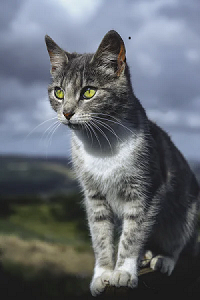The amount and frequency of meals depends on your cat’s age, health and preference.
Check the pet food aisle at your local supermarket, and you’ll find dozens of varieties of food to entice your cat. Feed your cat too little or the wrong kind of food, and he won’t maintain good health. Feed him too much, and he’ll get fat. But you can help get your cat off on the right paw by establishing regular feeding routines. Although the food you feed your cat should be complete and balanced, the simple answer to how often you should feed him is that there isn’t a simple answer.
Age Makes a Difference
Kittens require more food per pound of body weight to support their growth than do adult cats, and therefore should be fed more often throughout the day. “Growing kittens up to six months of age may require three meals a day,” says Francis Kallfelz, DVM, Ph.D., board certified by the American College of Veterinary Nutrition and James Law professor of nutrition at Cornell University College of Veterinary Medicine. “From age six months to maturity, most cats will do well when fed two times a day.”
Once the cat becomes an adult, at about one year, feeding once or twice a day is appropriate in most cases. Senior cats, age seven and above, should maintain the same feeding regimen. “Once cats reach adulthood, once a day feeding is fine as long as they are healthy and have no disease problems suggesting a reason to feed differently,” says Dr. Kallfelz.
The Health of Your Cat Matters
If your cat suffers from a health problem such as diabetes, you may need to feed him based on whenever he is administered insulin, depending on the type. “Talk to your veterinarian,” says Dr. Kallfelz.
If your cat has hyperthyroidism, he may want to eat all the time. “Treat the disease,” says Dr. Kallfelz. “If it is a treatable problem, treat it and then feed your cat normally.”
When a cat ages, his teeth may go bad, or he may develop gum disease that may make it difficult to chew dry food. “If they get to that point, then offer them canned food or dry in a finer nugget size,” says Dr. Kallfelz. You can also mash up the dry and mix it with water to make it easier to chew.
A Best Type of Food?
Many cat owners feed only dry food to their felines. “Dry food is fine as long as it is complete and balanced,” says Dr. Kallfelz. Dry food may be less expensive than canned cat food and may stay fresher longer. Cats that eat only dry food need to be provided with lots of fresh water, especially if they are prone to developing urinary tract blockages. For all cats, constant availability of fresh, clean water is important.
Canned cat food is typically about 70 to 80 percent water, and can be fed in addition to or instead of dry. Some cats may find canned food more palatable. These cats may consume too much if they are allowed free access to food. Of course, this may occur with dry food as well. “Food with average palatability may be preferable,” says Dr. Kallfelz. If it is extremely palatable, the cat may be more likely to overeat. If it is not quite so palatable, he may be less likely to overeat.
Super-sizing food portions is not just a problem for people. Since the feeding instructions on pet food labels are based on the needs of the average cat, you may be feeding more than necessary if your cat’s needs are lower than average. If you feed your cat dry food, you may provide it to him at specific mealtimes in measured quantities. Dry food can also be supplemented with a small amount of canned food to make meals more appealing.
“There’s no problem mixing the two types of food,” says Dr. Kallfelz. “Just make sure the calories are what your cat needs and not more.”
Free feeding dry food is acceptable for the cat who exercises self-control, but some cats like to snack, and for them, free feeding can add up to extra pounds. “If a cat can maintain his weight, free choice feeding is okay,” says Dr. Kallfelz. Even dry food left out for your cat to free feed needs to be fresh, so be sure to provide new food each day. If free feeding doesn’t work, you need to control how much they eat. “Several small meals may make them feel less hungry,” says Dr. Kallfelz. “But one is okay nutritionally.”
And here’s a useful hint: If you have a finicky cat, switching foods occasionally may help keep from him becoming hooked on only one diet.
Consider Your Schedule
How often you feed your cat may depend on your schedule as well. Mornings may be hectic as you get the kids off to school and yourself off to work. Under those circumstances, feeding your cat may be easier in the evening when it’s quieter and less busy. If you are running around a lot in the evening, feed your cat in the morning before everyone else is up. Find a schedule that works for you and your cat – and then keep it consistent.
In a multi-cat household, not all cats automatically come when called for dinner, potentially making it difficult for some to get food unless it is left out all the time. And other cats may eat too much when food is always available. “You just need to come up with a plan,” says Dr. Kallfelz. You can feed them separately or in different parts of the house.



